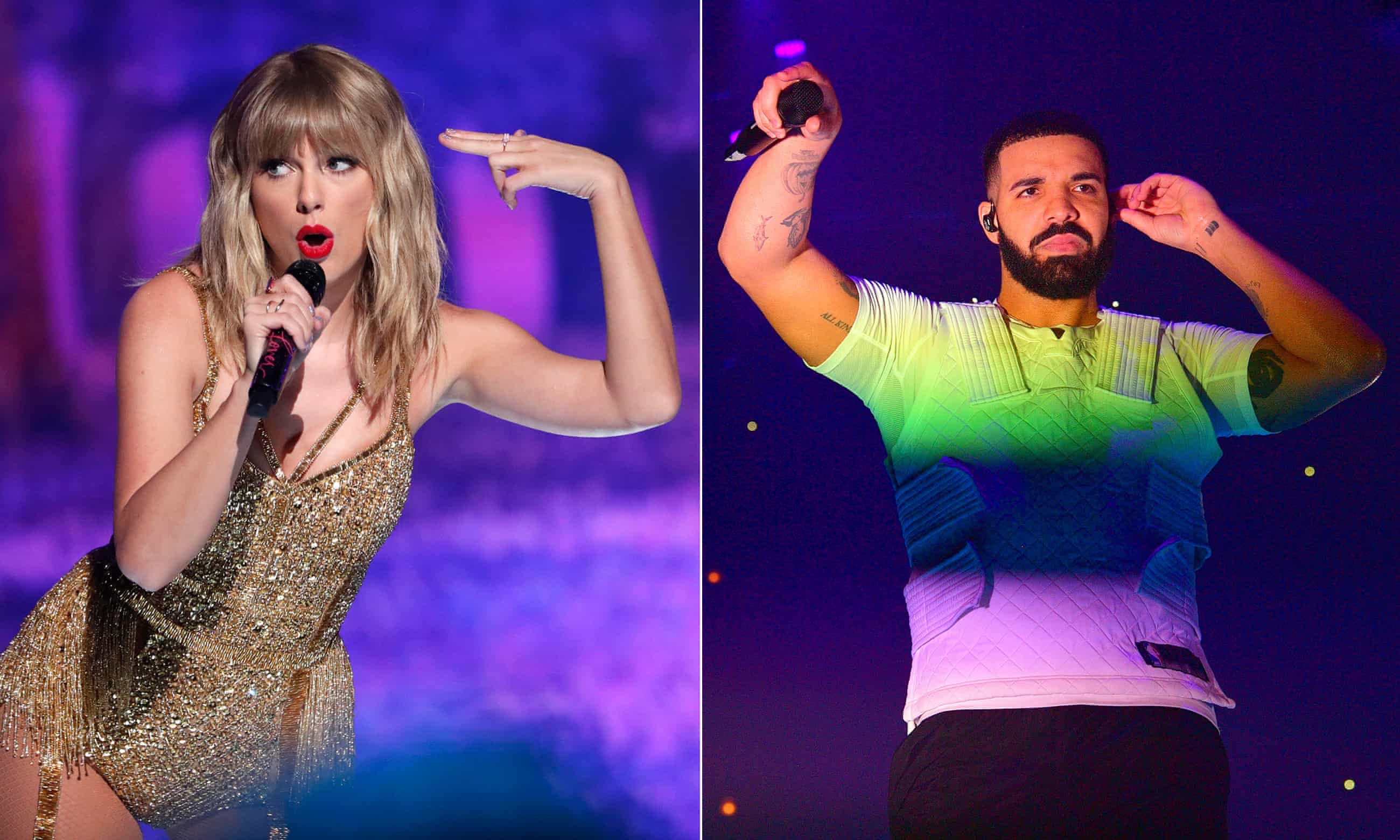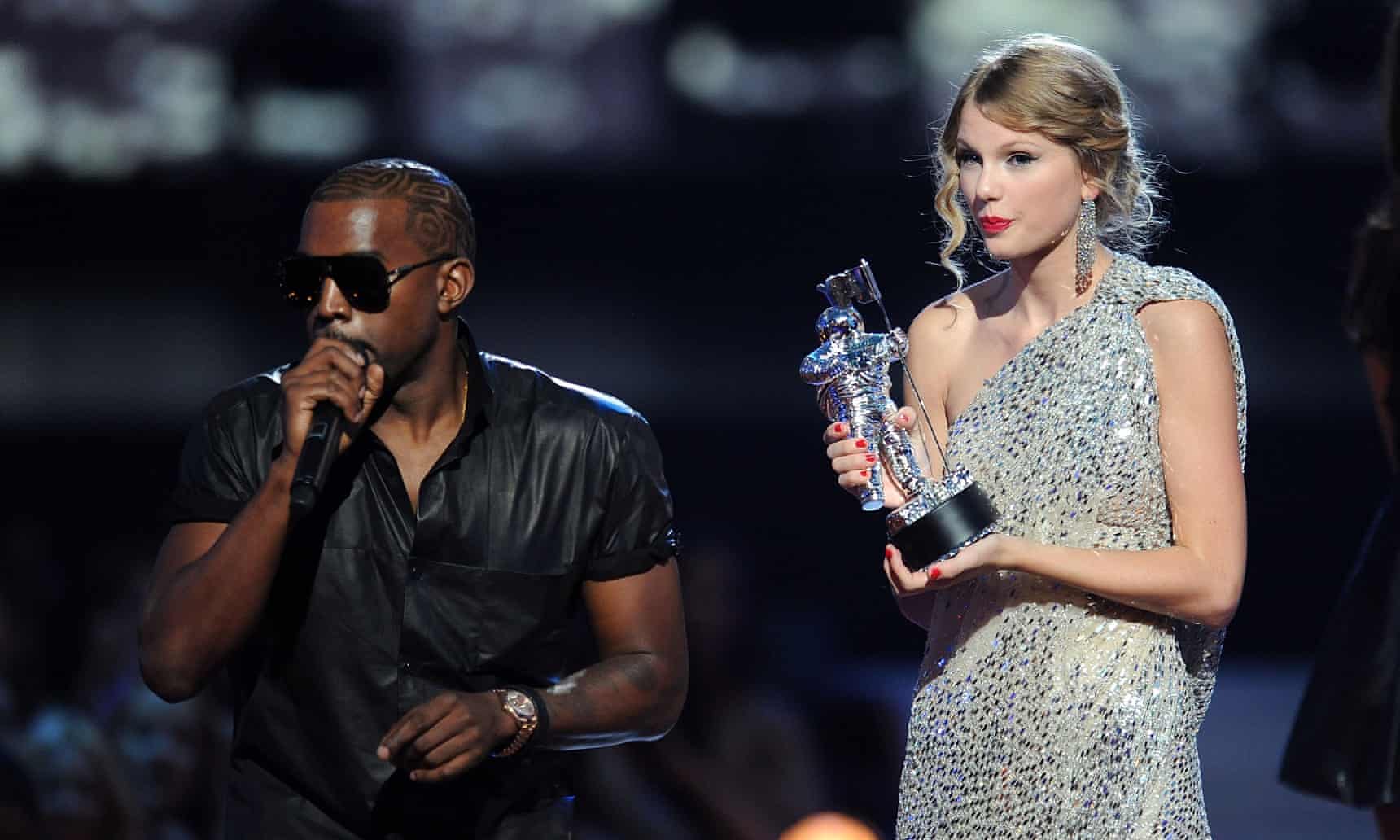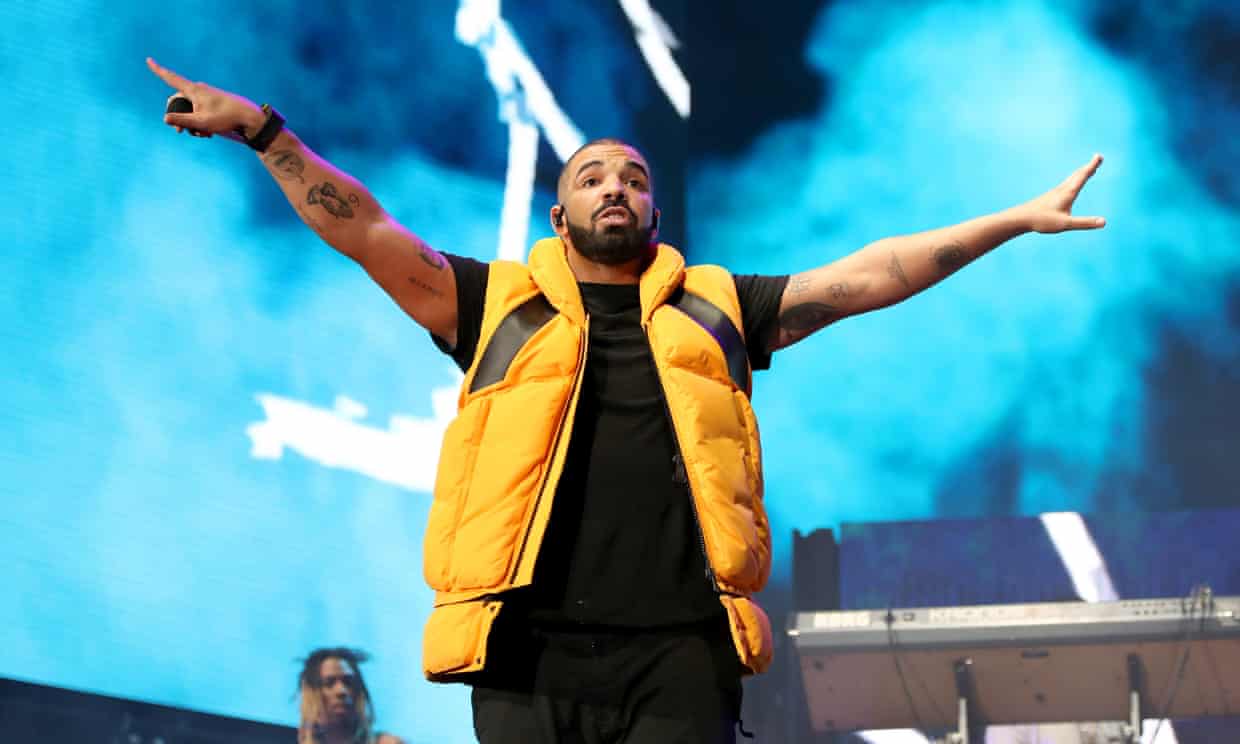
Love the game: Drake and Taylor Swift's decade in pop dominance
by Michael CraggSince 2009, Drake has become a cross-genre streaming star, while Swift’s glow-up has transformed her into a blockbuster brand – and their co-command of ‘pop 2.0’ isn’t wavering yet
The 2009 MTV Video Music awards represented a sea change for pop, the kindling of a handful of narratives that would shape its immediate future. The show started in mourning, with dancers paying tribute to one of pop’s original megastars, Michael Jackson, who had died three months earlier. When Janet Jackson emerged to perform their angry 1995 duet Scream, Beyoncé – the Jacksons’ heir apparent – looked giddy as a super fan. The type of megastar the Jacksons had helped create alongside Madonna and Prince – a spectacle-heavy mix of theatre, otherworldliness and determination – was present in a returning, and apparently rehabilitated, Britney Spears, and new pretenders Katy Perry, Lady Gaga and, of course, Beyoncé. But the night also represented ground zero for two of the forthcoming decade’s most influential artists, Taylor Swift and Drake, whose professional ambitions saw them adapt in divergent ways to a shifting landscape exploded by pop’s globalisation and a pervading please-all-comers mentality.
The show gave Drake his first ever VMA nomination for the soppy Best I Ever Had, a song that set the template for the softly melodic, minimalist fusion of sad-boi hip-hop and R&B that would eventually become pop’s dominant mode. For the then 19-year-old Swift, Kanye West interrupting her speech for best female video started a ripple-effect that would threaten to consume them both for the next decade. It also served as the catalyst for Swift’s transformation from country star to the subject of global discourse (Obama famously got involved, calling West a “jackass”). This unplanned cultural shift precipitated her move towards a more universal, pan-demographic sound – out went the country-pop scaffolding and in came Max Martin-assisted turbo pop on 2012’s Red.

Since that September night, the pair have gone on to crudely represent the two sides of pop’s current era. Late last year, the New York Times ran a piece announcing the arrival of “pop 2.0”, hailing Drake as its lodestar: he was 2018’s most streamed artist, with a ludicrous 8.2bn streams. Here was a modern-day icon who represented all things to all people: a mixed race, half-Jewish Canadian who sang as well as he rapped, and who diffused the perceived alienation of rap’s “bling” culture with emotionally vague songs that made the pitfalls of fame feel relatable. It also came cloaked in minimalist, vaporous production that, from 2016’s Views onwards, has cherry-picked from global genres such as dancehall (Controlla), UK funky (One Dance) and New Orleans bounce (Child’s Play). It’s an amorphous sound that’s made pop sadder and slower while recalibrating hip-hop, as proved by the emergence of Migos, Rae Sremmurd and French Montana. Drake’s only real rival for streaming dominance (in America anyway) is mopey singer/rapper Post Malone, whose albums contain a similar swirl of conflicting emotions, disparate sounds and undeniable hooks.
As critic Simon Reynolds pointed out, Drake’s music and artist persona are described best as “diffuse”, reflecting a new generation’s playful ignorance of genre lines and pop culture’s general distrust of “cool”. His vagueness means a song like Started From the Bottom, all unbridled braggadocio, still works coming from a middle-class former child star from Canada. It means he’s been able to access the credibility offered not only by Latin music behemoths such as Bad Bunny, but via his endearing enthusiasm for grime and UK rap: he has a BBK tattoo, for the British grime crew, appeared with Giggs at Reading festival, collaborated with Dave and Skepta, and earlier this year brought J Hus out at his O2 show for the London rapper’s first performance since being released from prison. It’s facilitated an extension of Drake’s empire while creating a mutually beneficial cultural exchange of credibility and exposure.
Rooted in this global discourse remains the notion of identity and whether, in our globalised culture, that still centres around your country of origin. Drake has always been obsessed with his hometown of Toronto (the cover of Views features him photoshopped on to the city’s CN Tower) and building a mythology around it that still connects him to the fundamentals of hip-hop’s civic pride. (A 2018 report suggested that 5% of Toronto’s tourism income, roughly $440m of the $8.8bn total, has come from Drake’s “rebrand” of the city.) His claims for Toronto as a hotbed for new talent, and himself as its talisman, were validated in 2011, when he took another of the city’s emotional young men, Abel Tesfaye, AKA the Weeknd, on tour with him after blogging about his early demos. Drake’s breakthrough Take Care album, released that same year, featured Tesfaye on five tracks including Crew Love, a naval-gazing ode to keeping friends close when fame gets too much. That Tesfaye would leave behind his introverted, hotbox R&B for arena-sized, Max Martin-assisted pop for 2015’s Beauty Behind the Madness also referenced Swift’s ambitious pop glow-up in the preceding years.

Audience cross-pollination and zig-zagging across now almost non-existent genre lines has defined the most influential artists of the decade. It’s why Ed Sheeran, who has always been cynically honest about how he creates an album – ballads for first dances at weddings; vaguely R&B adjacent hits for the clubs he doesn’t go to; “anthemic” rock standards for the stadiums – has steadily become pop’s only true rival to Taylor Swift and Drake. (Adele, meanwhile, exists outside a pop conversation in which she has largely declined to participate.) It’s the same with genre-hopping dance music behemoths Calvin Harris and Diplo, the latter having jumped on so many cultural bandwagons he must have full-body splinters. Even recovering indie sad sacks Coldplay started the decade with the Rihanna-featuring Mylo Xyloto before working with her sometime producers Stargate, then Avicii and EDM bros the Chainsmokers. This catch-all mentality means they’ve rarely been off the Radio 1 playlist and have a healthy 34m monthly Spotify listeners.
For “pop 2.0”, streaming figures are the new godhead, which has re-shaped music consumption. Drake has favoured the surprise route, often chucking songs on streaming platforms with zero fanfare and no official video, while typical album releases are bookended by “mixtapes” (2015’s If You’re Reading This It’s Too Late) or “playlists” (2017’s More Life), semantic reclassifications that play into the streaming vernacular. That those two releases were commercially available, eligible for chart classification and in every other way conformed to fans’ expectations of Drake “albums” didn’t matter: Drake became the streaming artist, manipulating the medium’s possibilities and making bodies of work that represented how a new generation consumes music.

Swift prefers the excitement of delayed gratification and the possibilities of preserving a monoculture for her to dominate. Her initial stand against streaming – in 2014 she pulled her music from Spotify, and a year later wrote an open letter criticising Apple Music’s practices – cast her in some quarters as fighting against progress. Although she returned her albums to streaming platforms, for her 2019 comeback single Me! she remained committed to an almost anachronistic teasing strategy: “Easter eggs”, global video premieres and announcements teeing up future announcements. When Ariana Grande shifted to a more immediate release schedule, knocking out two albums in nine months and becoming one of the world’s biggest pop stars in the process, Swift’s conventional love of album “eras”, typically spaced two or three years apart, felt out of step.
For a long time, there wasn’t a dent in Swift’s armour. Having built up a significant authenticity quota from her teenage days in songwriting capital Nashville, Swift used 2012’s Red as a way of broadening her audience. Like forebear Shania Twain, and setting a template for the likes of Kacey Musgraves, Maren Morris and even Ellie Goulding to follow, Swift peppered her country-rock with blasts of industrial-strength pop, often in conjunction with Max Martin, who created a new superstar template with Britney Spears and the Backstreet Boys in the late 1990s. Two years before Red, Martin had also helped turn Katy Perry into a bonafide star, with her record-breaking Teenage Dream album cementing pure Swedish hit-factory pop as a US radio staple. While Perry added a hedonistic swirl to the mix, Swift’s brand was more PG-13, with the goofy We Are Never Ever Getting Back Together and 22 perfect for stadium sing-alongs and pre-teen birthday parties. As pop crept away from the avant-garde otherworldliness of Lady Gaga, Swift provided, at least initially, enough girl-next-door realness to keep things universally appealing.
Red and the sleek electro-pop of 2014’s 1989 sold by the bucketload (the latter topped 9m in the US alone), bucking a global sales decline by keeping a focus on physical product. If Drake’s star quality was built on being a new kind of everyman, where loyalty could be quantified in streams in their billions, for Swift it’s always been a connection forged via brand specificity and old-school sales metrics. (In a 2015 interview with Q, Sheeran confessed that the pair often exchanged sales figures via text.) Using the physical product as part of the album’s world became key. The packaging for 1989, for example, cleverly tapped into the social media-facilitated shift in the relationship between pop stars and fans, offering collect-them-all “Polaroids”, while the deluxe edition offered an insight into Swift’s artistry through three intimate “voice memos”.
Her most recent album, Lover, became the biggest selling American “pure sales” release of 2019 after just two days on sale. It reflected K-pop’s impact on pop, with fans noting that its deluxe version – a hardback book available in varying colours – was similar to those released by the biggest exports of the Asian market, where physical products are still fetishised. Targeting Asian markets more explicitly has also defined the Lover era, with a recent trip to Japan followed by a performance in China at the launch of Singles’ Day, the nation’s biggest e-commerce shopping spree, and elaborate meet-and-greet events.
As the decade has progressed, a generation has established a complex relationship with authenticity. While fans prize “realness” in their pop stars, “selling out” is no longer a crime: most pop videos are littered with enough gadget product placement to fill a PC World, and when failed businessmen can become president, exposure and financial gain are revered. When Swift teamed up with UPS for the campaign for her 2017 album Reputation, or with Amazon for Lover, or joined Drake for a 2016 campaign advertising Beats 1, some sneered, but such grabs for marketplace dominance have become entrenched in modern entertainment. Perhaps Swift’s biggest impact this decade has been how quickly she herself has become a brand, and how clearly that brand – the head girl-focused leader who’s always looking out for you – has cemented its ideals.
So where do we find pop’s two dominant forces in 2019? And what does it mean for the supposed death of pop 1.0? For Drake, his harnessing of pop’s globalisation has meant that R&B and hip-hop now completely exist in his image. By collaborating cleverly across genre and country lines, he’s ridden musical waves that were already beginning to crest: even as non-English-language pop becomes more dominant, Drake thrives because his lyrics are sufficiently vague to have myriad meanings, or meme-ready enough to be universal slogans. Swift is more complicated, possibly the last old-school megastar. Lover acted as a brand stabiliser after the turbulence of Reputation, but by adhering to traditional release strategies, she feels at odds with current pop’s looser spontaneity, as defined by artists such as Ariana Grande and Rosalía. Still, Swift’s dominance this decade means her blockbuster brand is basically indestructible, so ingrained is she in the fabric of pop culture. Once you’ve levelled up to pop’s top tier, culture’s shifting sands are just another reason to keep moving.